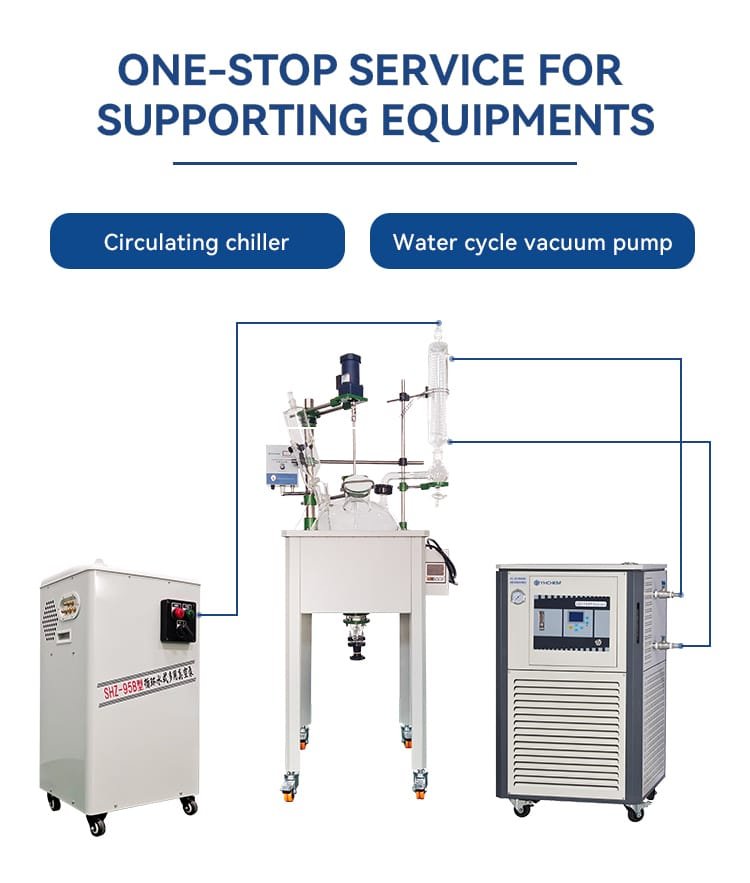Essential Safety Measures for Handling Your Single Glass Reactor
The single glass reactor is an indispensable tool in chemical laboratories, widely used for conducting reactions requiring controlled temperature, pressure, and stirring. However, ensuring its safe operation is paramount to avoid accidents and equipment failure. The importance of following the Single Glass Reactor Safety Guidelines cannot be overstated. Adhering to these safety protocols not only protects the laboratory personnel but also preserves the functionality and longevity of the reactor itself.

1. Understanding the Basics of Reactor Safety The primary purpose of the Single Glass Reactor Safety Guidelines is to minimize risks associated with handling and operating glass reactors. These reactors often deal with volatile or hazardous materials, making safety a top priority. Adhering to established safety protocols ensures that chemical reactions are performed under optimal conditions, reducing the likelihood of dangerous incidents.
2. Proper Handling of the Single Glass Reactor Correct handling of the single glass reactor is a fundamental safety guideline. These reactors are made of delicate glass, and mishandling can result in cracks or breakage. Always handle the reactor with care, and ensure that it is placed on stable surfaces. Never lift the reactor by any protruding parts such as the stirrer or thermometer. When transporting the reactor, use suitable protective equipment like padded trays or containers to prevent physical damage.
3. Ensuring Proper Installation and Setup Before using the single glass reactor, ensure that it is installed correctly. The reactor should be set up on a stable workbench or platform that can support its weight. The connections for heating, cooling, and pressure monitoring should be securely attached. Double-check that the sealing and gasket components are properly installed to avoid leaks. Ensuring a proper setup is one of the most important Single Glass Reactor Safety Guidelines to avoid failures during operation.
4. Pressure and Temperature Monitoring One of the critical aspects of operating a single glass reactor is monitoring temperature and pressure. Ensure that both the temperature and pressure gauges are calibrated and functioning correctly. Overheating or excessive pressure can lead to dangerous consequences, including glass rupture or violent reactions. Make sure to regularly check and maintain the temperature control system and pressure relief valves. Keeping the reactor within the recommended operating limits is crucial for safety.
5. Avoiding Contamination To ensure safe operation, avoid cross-contaminating the reactor with incompatible substances. Always clean the reactor thoroughly after each use to remove any leftover chemicals or residues. Use appropriate solvents and cleaning agents, and follow the manufacturer’s instructions for cleaning to prevent damage to the glass. Contaminated reactors can lead to hazardous reactions and undermine the safety of your laboratory.
6. Emergency Protocols and Preparedness In any laboratory, it’s essential to have emergency protocols in place. Ensure that all personnel are trained in the proper steps to take in case of an emergency, such as a leak, fire, or glass breakage. Keep emergency equipment, such as fire extinguishers, first-aid kits, and eyewash stations, readily accessible. Be aware of the location of emergency exits, and ensure that they are easily reachable.
7. Regular Inspections and Maintenance Regular inspections are a key part of the Single Glass Reactor Safety Guidelines. Make it a routine to check the reactor for any signs of wear, such as cracks in the glass or corrosion on metal components. Always inspect the seals, gaskets, and joints for signs of leaks or degradation. Perform necessary maintenance to replace any worn-out components, ensuring the reactor operates safely and efficiently. If a part is damaged, it should be replaced immediately to prevent further issues.
8. Proper Use of Protective Gear Wearing the correct protective gear is vital when operating a single glass reactor. Always wear lab coats, gloves, and goggles to protect yourself from chemical splashes and broken glass. In some cases, additional personal protective equipment (PPE), such as face shields or respirators, may be necessary depending on the chemicals being used. Proper PPE helps ensure that even in the event of an accident, you are adequately protected.
9. Dealing with Glass Breakage Glass breakage is a potential hazard when working with a single glass reactor, especially when exposed to sudden changes in temperature or pressure. In the event of a breakage, follow the appropriate safety procedures. Use tongs or gloves when handling broken glass, and dispose of it in designated glass disposal containers. Avoid using excessive force when installing or removing parts from the reactor to minimize the risk of breakage.
10. Safe Disposal of Chemicals After completing your experiments, safe disposal of chemicals is critical to maintaining a safe laboratory environment. Never dispose of chemicals in regular trash or down the drain unless it is confirmed to be safe to do so. Always follow the proper disposal guidelines for each chemical used in your single glass reactor. Dispose of waste chemicals in designated containers, and ensure that the disposal process aligns with local regulations.
Maintaining Your Single Glass Reactor with Expert Support For optimal safety, it is important to regularly consult the manufacturer’s guidelines for your single glass reactor. If you’re unsure about any part of the maintenance process, consider reaching out to experts for advice or service. If you’re looking to upgrade or maintain your reactor, you can explore options like the 10L Single Layer Glass Reactor available at EquilRxnLab, where you can also find support and guidance on best safety practices.
Links for Further Reference:



